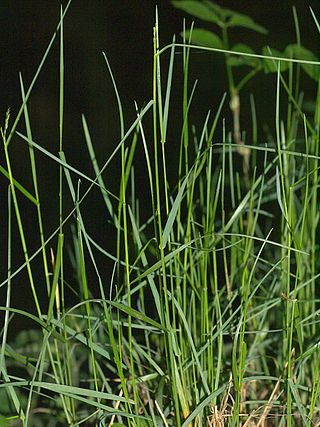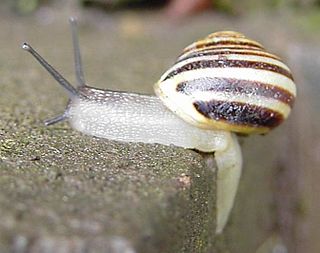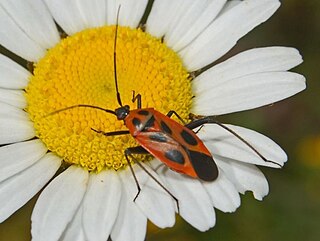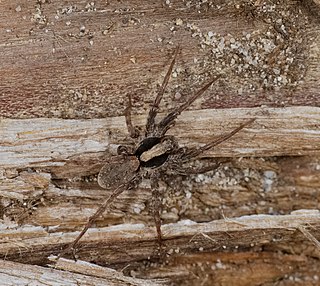
The grove snail, brown-lipped snail or lemon snail is a species of air-breathing land snail, a terrestrial pulmonate gastropod mollusc.

The white-lipped snail or garden banded snail, scientific name Cepaea hortensis, is a large species of air-breathing land snail, a terrestrial pulmonate gastropod mollusc in the family Helicidae. The only other species in the genus is Cepaea nemoralis.

Poa nemoralis, the wood bluegrass, is a perennial plant in the family Poaceae. The late-growing grass is fairly nutritious for livestock, which feed on it in the autumn, and it is used as a lawn grass for shady situations.
The elm cultivar Ulmus 'Nemoralis' was listed by Schelle in Beissner et al. (1903), as U. campestris f. nemoralisHort. Considered "possibly U. carpinifolia " by Green.

Cepaea is a genus of large air-breathing land snails, terrestrial pulmonate gastropod molluscs in the family Helicidae. The shells are often brightly coloured and patterned with brown stripes. The two species in this genus, C. nemoralis and C. hortensis, are widespread and common in Western and Central Europe and have been introduced to North America. Both have been influential model species for ongoing studies of genetics and natural selection. Like many Helicidae, these snails use love darts during mating.

Agrotera nemoralis, the beautiful pearl, is a species of moth of the family Crambidae. It was first described by Giovanni Antonio Scopoli in his 1763 Entomologia Carniolica.

Solidago nemoralis is a species of flowering plant in the family Asteraceae. It is native to North America, where it is widely found in Canada and the United States. Its common names include gray goldenrod, gray-stem goldenrod, old-field goldenrod, field goldenrod, prairie goldenrod, dwarf goldenrod, and dyersweed goldenrod.

Calocoris nemoralis is a species of true bugs belonging to the family Miridae or jumping tree bugs, subfamily Mirinae.
Glipostena is a genus of beetles in the family Mordellidae, containing the following species:

Mordellinae is a subfamily of beetles commonly known as tumbling flower beetles for the typical irregular movements they make when escaping predators, or as pintail beetles due to their abdominal tip which aids them in performing these tumbling movements.
Glipostena congoana is a species of beetle in the genus Glipostena. It was discovered in 1952.
Glipostena sergeli is a species of beetle in the genus Glipostena. It was discovered in 1942.
Glipostena dimorpha is a species of beetle in the genus Glipostena. It was discovered in 1999.
Glipostena hogsbacki is a species of beetle in the genus Glipostena. It was discovered in 1999. It is known from Sulawesi.
Glipostena medleri is a species of beetle in the genus Glipostena. It was discovered in 1999.
Glipostena nigricans is a species of beetle in the genus Glipostena. It was discovered in 2000.
Glipostena pelecotomoidea is a species of beetle in the genus Glipostena. It was discovered in 1911.
Glipostena ponomarenkoi is an extinct species of beetle in the genus Glipostena. The species was described from the late Eocene Rovno amber of Ukraine in 2009.

Anthocoris nemoralis is a true bug in the family Anthocoridae. The species is native to Europe and is introduced in North America. It is a predator of aphids, spider mites and jumping plant lice, and is therefore used as a biological pest control agent.

Xerolycosa nemoralis, or the burnt wolf spider, is a species of wolf spider found from western Europe eastwards to the Pacific.









